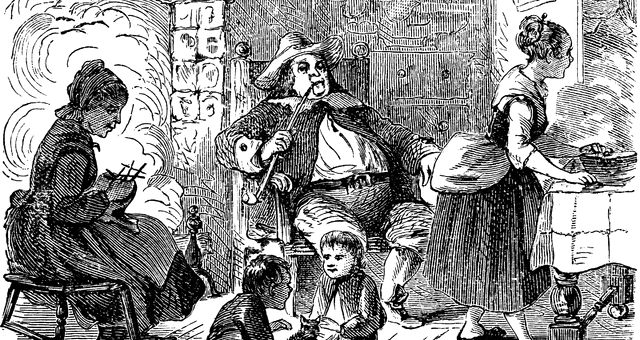Baby It’s Cold Outside!
January, February, March. Turn up the heat! In our homes today, that means to go to our thermostat and turn a dial or punch in a number. And, of course, our phones can do the job as well. The temperature will rise and we go about our business in comfort. But what about our colonial American ancestors? How did families cope with the coldest, darkest days of winter when our modern furnaces were centuries in the future? Let’s take the time of the Graeme family – winters of the mid-1700s in Pennsylvania. The colonial hearth was the heart of the home and for good reason. It provided light after dark, heat for cooking and in the winter, lifesaving heat for the people in the room. In our idyllic image of colonial America, we see a family gathered around the hearth with a blazing fire in the background. Perhaps the mother is sewing or mending, the father is reading or sharpening his farming tools and the children are sprawled on the floor reading or playing. All is cozy and warm. Our image is not necessarily reality, however, since this family togetherness by the fireplace was more necessary for survival than a jolly good time.
Preparing for winter’s cold was an all-year, full-time job. Wood had to be chopped and ready. Without an ample supply of wood for cooking and warmth, there was little else for heat and it could mean the difference between life and death. Some families had small heating elements called braziers, which would use coal for heat, but these were supplementary heaters and the warmth generated by these units was not enough to fend off a chill.
Once winter set in, staying warm was a constant struggle. Houses could go as low as 20 degrees. Remember, insulation as we know it today was not invented yet. A good roaring fire might bring a room up to only 40-50 degrees, depending on the outside temperature. It was said that if a person stood with his back to the fire, he or she could burn their backside while their fingers froze in front. This was because the heat from the fireplace would mostly go right up the chimney and out into the cold. It was not uncommon to have a fire going strong but a mere ten feet from the fire, to have eggs, milk and even ink freeze.
Families would gather in the smallest room of the home since heating larger rooms was almost impossible. Even the wealthy with mansions of many rooms had to huddle into the littlest area to feel any essential heat. And leaving the room for any reason was difficult as the cold from the other parts of the house would rush in when the door was opened. There is a story of Thomas Jefferson bringing his new bride to his Virginia home in January, 1772. After hours of shivering in the cold during the ride from her parents’ home, he arrived to find that the servants had banked the fires and gone to bed. The house was freezing! So they went to a small cottage on the property and tried to warm that up with a fire in the hearth. There was no possible way for them to bring heat to the big house in a decent amount of time. The smaller the square footage, the more possible to feel the heat. Also, colonists would dress in many layers of thick, woolen garments to help hold in what body heat they had to supplement the meager warmth in the room.
Most often, when it was time for bed, the fires were left to die out as keeping an unattended fire during the night could be dangerous with a possible errant flying ember eventually causing the house to burn. Only residual heat was in the bed chamber and by morning, the temperatures could be quite below freezing before a new fire was blazing again.
It was a cruel and constant struggle and though Currier and Ives paint a charming picture of a horse-drawn sleigh coming up the snowy drive to a lovely home with beckoning light in the windows where we believe warmth awaits the travelers once they enter, that was not necessarily the case on the coldest, darkest days of a colonial Pennsylvania winter. As I write this, I hear my heater kicking in and whisper a word of thanks for this modern convenience.

